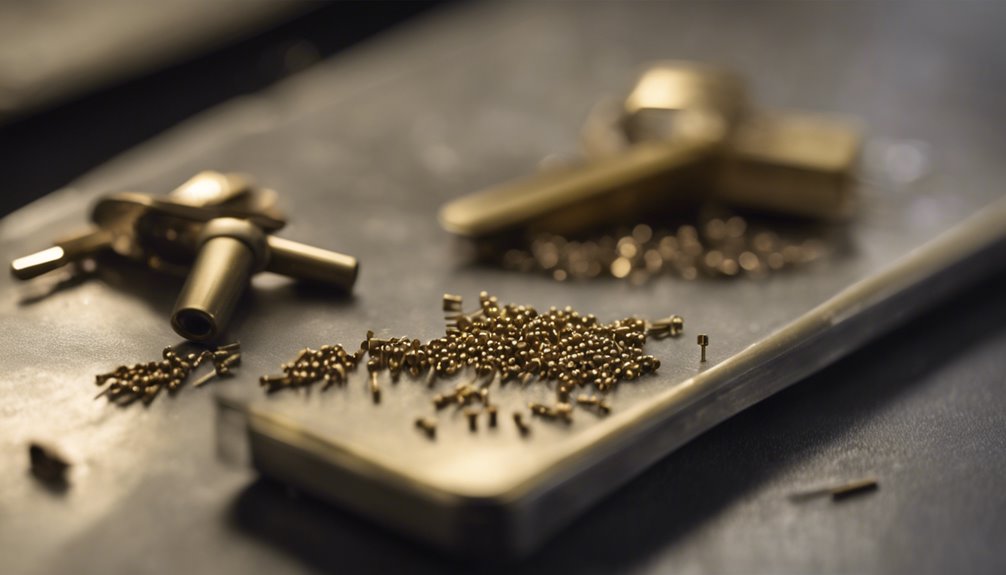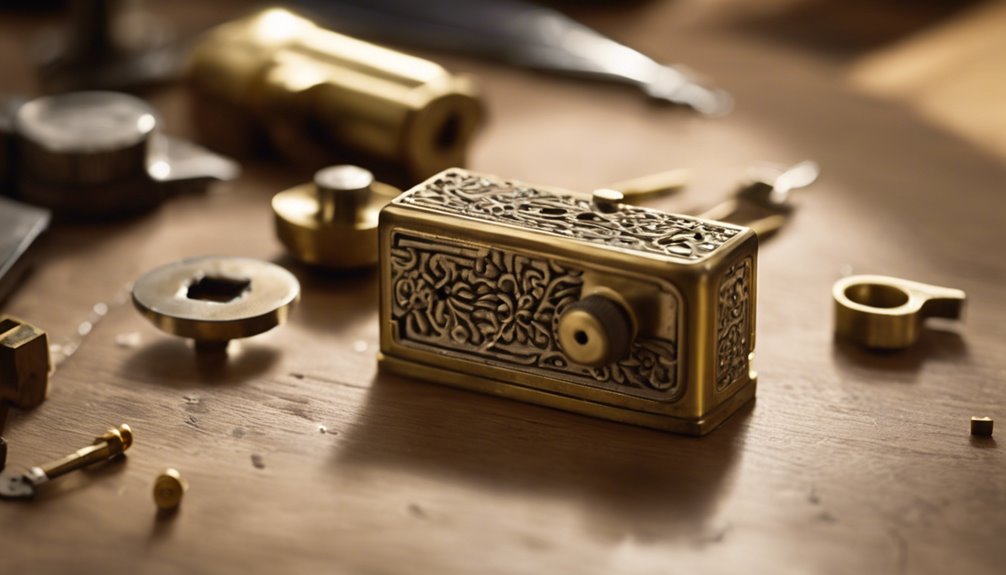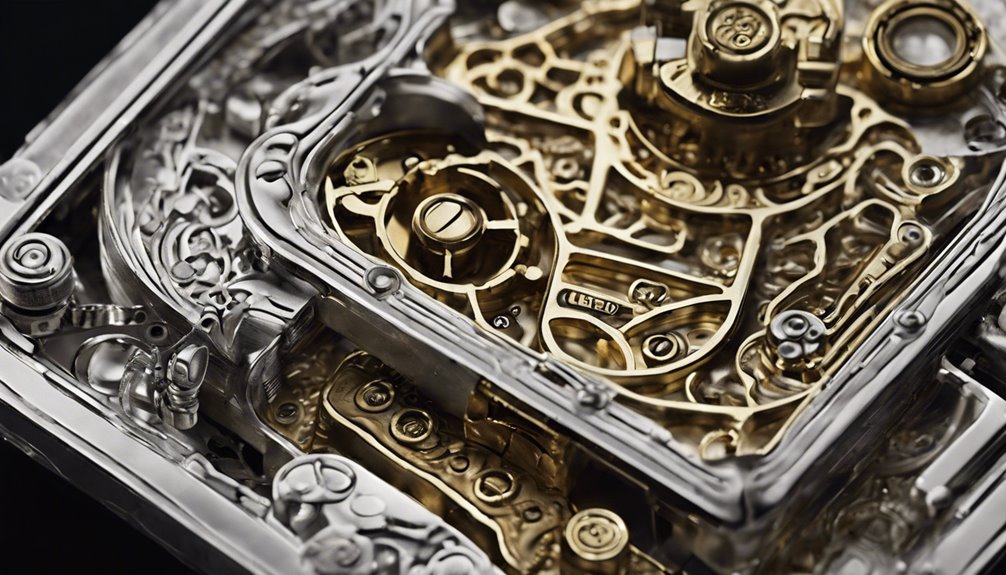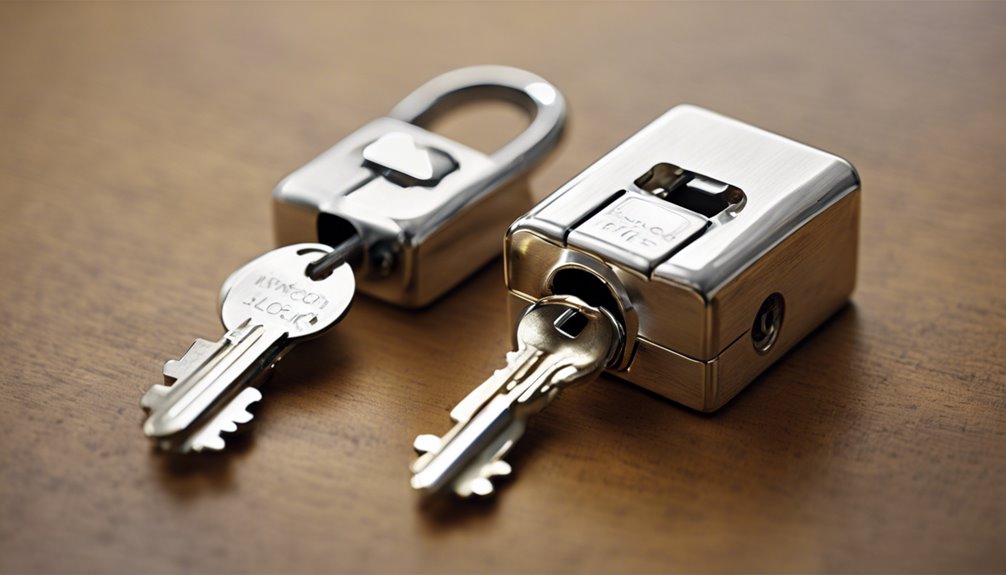You might think pin tumblers and wafer locks offer similar security, but they differ considerably. Pin tumbler locks boast intricate mechanisms with multiple pins that align precisely, providing superior defense against picking. In contrast, wafer locks have simpler designs, making them more susceptible to manipulation. Understanding these differences is essential in choosing the best lock for your needs. Let’s explore how these mechanisms impact security, cost, and installation to guarantee informed decisions.
Key Takeaways
- Pin tumbler locks offer superior security with complex mechanisms and anti-pick features compared to simpler wafer locks.
- High-security pin tumbler locks include advanced technology and patented designs, providing robust protection against unauthorized access.
- Wafer locks are more vulnerable to picking and rake attacks due to their simpler structures and lack of advanced security features.
- Pin tumbler locks have a longer lifespan and lower maintenance needs, making them suitable for high-security applications.
- Wafer locks are more budget-friendly but compromise on security and durability, making them suitable for cost-sensitive, low-security applications.
Complexity and Mechanism
When it comes to understanding the complexity and mechanism of pin tumbler locks, you’ll find that their intricate design plays an essential role in their operation and security. Each lock houses a series of pins: key pins at the bottom and driver pins on top, designed to interact precisely with the key’s unique cuts. This alignment at the shear line is vital for the cylinder’s rotation. Innovative pin types, like spool and serrated, complicate unauthorized access, enhancing security. The keyway’s design, with its protruding ledges, further deters tampering by preventing pins from falling into the plug. Despite the ease of manufacturing pin tumbler locks, their vulnerabilities led to the development of more secure options such as disc detainer locks. Operating a pin tumbler lock requires exact alignment; even a slight mismatch blocks the plug’s rotation. This precision, while offering security, also presents vulnerabilities. Skilled individuals might exploit the mechanical tolerances, and tools like comb picks can bypass poorly maintained locks. Despite these challenges, the intricate design remains a robust defense mechanism.
Levels of Protection

When evaluating the levels of protection between pin tumbler and wafer locks, you’ll find that pin tumbler locks offer superior security due to their complex mechanisms and anti-pick features like mushroom and spool pins. Additionally, deadbolts provide an extra layer of security enhancement that can complement the use of pin tumbler locks for exterior doors. Wafer locks, on the other hand, are more vulnerable to picking and rake attacks because of their simpler structure and lack of advanced security enhancements. High-security pin tumbler locks further enhance protection with features like patented key designs and BumpStop technology, making them a reliable choice for safeguarding valuable assets. Moreover, their robust logging and monitoring capabilities provide valuable insights into access control management, ensuring enhanced security. Modern pin tumbler locks have a long-standing history of adaptability and effectiveness, stemming from advancements made since their origin in the ancient Egyptian era.
Pin Tumbler Complexity
Although the complexity of pin tumbler locks might seem intimidating at first glance, it’s this very intricacy that guarantees a robust level of protection. Each lock uses a unique arrangement of driver and key pins, requiring precise alignment to meet the shear line. The key design corresponds to these specific pin heights, ensuring only the correct key operates the lock. Innovative security features like spool, serrated, and mushroom pins enhance resistance against picking attempts. These specialized pins create false feedback for unauthorized manipulators. High-security locks further incorporate pin-in-pin configurations and gin bottle pins, adding layers of complexity. Additionally, the narrow keyway and the use of multiple pins make picking exceptionally challenging, elevating the lock’s defensive capabilities.
Wafer Lock Vulnerabilities
Wafer locks present a different security landscape. Their poor tolerances make them vulnerable to exploitation by jigglers or try-out keys, allowing unauthorized access through their weak design. Most wafer tumbler locks fall prey to these flaws, becoming easy targets for raking techniques. Unlike the intricate pin tumbler locks, wafer locks are simpler to pick, particularly when worn or using single wafer designs. They also succumb to forced entry methods like drilling and bumping, offering less resistance than their pin-based counterparts. Despite being suitable for low-security applications like cabinets or desks, wafer locks prioritize convenience over security, often compromising safety for cost-effectiveness. For enhanced security, guarantee quality materials and design complexity. Additionally, regular lock maintenance can help mitigate vulnerabilities and is crucial for ensuring the longevity of locks.
Security Enhancement Features
Even as wafer locks cater to low-security needs, pin tumbler locks offer advanced security enhancement features that elevate them to a higher level of protection. You’ll find narrow keyways in pin tumbler locks that restrict tool insertion, making them tough to pick. Some even have wards or obstructions for added complexity. Security pins, like spool or serrated variants, are engineered to catch improper manipulation, frustrating attempts at picking. Master keying systems in these locks allow for efficient access control, integrating sidebars and extra pins for heightened security. High-security cylinders further bolster protection with specialized pins and anti-drill plates, countering common attacks. These features guarantee pin tumbler locks remain a smart choice for those seeking innovative security solutions. Additionally, fail-secure locks are crucial as they protect valuables during emergencies, ensuring continued security in an increasingly demanding environment. When choosing between lock types, individuals should consider specific safety and security needs to determine the best option for their situation.
Vulnerabilities and Weaknesses

When evaluating the vulnerabilities of locks, you should focus on their susceptibility to picking and the design of their keyholes. Pin tumbler locks, while generally more secure, can be picked due to imperfections in pin chamber alignment and the use of standard pins. On the other hand, wafer locks have wider keyways that make them easier to manipulate, leaving them particularly vulnerable to basic picking tools.
Lock Picking Susceptibility
While pin tumbler locks are widely regarded for their security, they possess certain vulnerabilities that can be exploited. Their reliance on precise pin alignment makes them susceptible to manipulation. With lock picking tools easily accessible and techniques quickly learned online, even a novice can become adept at bypassing these locks. Regular assessments by professionals are essential to maintaining their security effectiveness. Additionally, integrating comprehensive security systems helps to create a fortified environment against potential breaches. By embracing proactive security measures, individuals can significantly mitigate the risks associated with vulnerable lock types.
| Lock Type | Vulnerability | Security Level |
|---|---|---|
| Pin Tumbler | Pin misalignment | Higher |
| Wafer | Simple structure | Lower |
| High-Security | Specialized tools | Highest |
Wafer locks, with their less complex structure, are even easier to pick. They’re commonly found in less secure applications, offering convenience and cost-effectiveness at the expense of security. Embrace innovation by evaluating these vulnerabilities and enhancing your lock systems.
Keyhole Design Flaws
Pin tumbler and wafer locks demonstrate varying levels of susceptibility to picking, but keyhole design plays a significant role in their overall security. Simple, round keyholes, often seen in wafer locks, are easier to pick, allowing tools direct access to locking mechanisms. This vulnerability is evident in unshielded keyways, like those in the ABUS 82 series, where specific tools can bypass the lock with ease. Conversely, innovative designs such as hidden or baffled keyholes enhance security by concealing the entry point, making unauthorized access challenging. Technologies like “non-hole” designs further reduce picking risks by eliminating visible keyholes. While pin tumbler locks generally offer higher security with narrower keyways, evolving your keyhole design is essential to staying ahead of potential threats. Regular lock maintenance, including lock inspection services, ensures any vulnerabilities in your security setup are promptly identified and addressed. Additionally, engaging 24-hour emergency lockout services can provide immediate assistance in case of a lockout scenario, ensuring minimal disruption to your operations.
Security Layers and Features

Although both pin tumbler and wafer locks serve as security solutions, their layers and features reveal distinct differences in complexity and effectiveness. With pin tumbler locks, you encounter a sophisticated system of pins and key alignment that provides robust security. Here’s why:
- Key Control and Alignment: The interaction between driver and key pins guarantees precision. Each pin requires perfect key alignment at the shear line, complicating unauthorized access.
- Pin Types and Variations: Utilizing standard, spool, and serrated pins, pin tumbler locks incorporate anti-pick features like mushroom and security pins, which considerably deter lock-picking.
- Mechanical Security Enhancements: High-security keyways and master keying systems allow multiple access levels, integrating seamlessly with modern access control systems.
- Design and Construction: Their durable, intricate build and narrow keyways make them resistant to picking, offering long-lasting security.
In contrast, wafer locks are simpler and cost-effective, but lack the intricate layers of security offered by pin tumblers.

When considering resistance to unauthorized access, you’ll find pin tumbler locks offer superior complexity, making unauthorized entry more difficult. Wafer locks, however, are more vulnerable due to their simpler design, which can be exploited by skilled intruders. Pin tumbler locks also benefit from enhanced security features, providing an added layer of protection against various tampering methods.
Pin Tumbler Complexity
In the domain of lock security, pin tumbler complexity stands as a formidable barrier to unauthorized access. Leveraging advanced pin designs and security features guarantees that these locks resist manipulation efforts effectively. Here’s why pin tumblers excel:
- Advanced Pin Designs: Utilizing multiple pin stacks and unique configurations like spool and mushroom pins makes traditional lock-picking techniques obsolete.
- Security Features: Technologies such as BumpStop and anti-drill plates enhance physical security, while key control systems prevent unauthorized duplication.
- Key Control and Authentication: Restricted and patented keyways, combined with electronic management, guarantee only authorized access and immediate alerts for breaches.
- Enhanced Security Mechanisms: Anti-pick pins and high-security materials, such as hardened steel components, fortify locks against unauthorized access attempts.
This complexity makes pin tumbler locks a robust choice for security.
Wafer Lock Vulnerability
Wafer locks, while commonly used for their simplicity and compact design, present significant vulnerabilities regarding resistance to unauthorized access. Their flat, rectangular wafers, integral to their function, are easier to manipulate than the complex pins of pin tumblers. With techniques like raking and single wafer picking, bypassing these locks requires minimal tools and expertise. The tools for these methods are often inexpensive and readily available, making wafer locks an attractive target for unauthorized access. Structural weaknesses further diminish their security, allowing techniques like core shimming to exploit gaps for easy manipulation. Compared to pin tumbler locks, wafer locks offer less resistance, making them a less secure option where high security is a priority. Prioritize advanced solutions for enhanced protection.
Enhanced Security Features
Understanding the vulnerabilities of wafer locks highlights the pressing need for more secure alternatives like pin tumbler locks, which offer enhanced security features against unauthorized access. Pin tumbler locks employ precise alignment, ensuring only the correct key raises the pins to the shear line, allowing the cylinder to rotate securely. Here’s why they excel in security:
- Unique Key Configurations: They utilize keys with cuts matching specific pin heights, preventing unauthorized access.
- Anti-Pick Features: Incorporating security pins like mushroom or spool pins complicates lock picking.
- Interchangeable Cores: Facilitate quick rekeying, enhancing security by allowing for rapid upgrades.
- High-Security Keyways: Resist picking and bumping, greatly reducing unauthorized entry risks.
These attributes make pin tumbler locks a superior choice for those seeking innovative security solutions.
Durability and Longevity

When evaluating the durability and longevity of lock systems, pin tumbler locks emerge as a robust option due to their design aimed at withstanding frequent use and high-security demands. Crafted from high-quality materials, these locks resist wear and tear, ensuring they last longer than wafer locks. Their resilience against environmental factors like dust and moisture further enhances their lifespan, often outlasting wafer locks when properly maintained.
However, the complex mechanism of pin tumbler locks can sometimes lead to jamming if not regularly maintained. They demand precise keys for ideal performance, making key quality essential. Although sophisticated, they’re not impervious to skilled lock pickers.
On the other hand, wafer locks, with their simpler design, are less prone to jamming but generally offer a shorter lifespan. They’re more vulnerable to environmental damage and require careful maintenance and high-quality materials to extend their durability. Proper installation also plays a significant role in their longevity.
Cost and Economic Considerations

Although pin tumbler locks are generally more secure and durable, their cost is considerably higher due to several factors. You’ll find that these locks require complex materials and manufacturing processes, which inherently increase production expenses. Let’s break down the costs:
- Material Costs: The intricate design and quality of materials used in pin tumbler locks lead to higher production costs compared to wafer locks.
- Specialized Tools: Manufacturing pin tumbler locks necessitates specialized tools, driving up costs further.
- Market Price: Their security features and durability mean pin tumbler locks command a premium price in the market.
- Maintenance and Replacement: While initially more expensive, their extended lifespan and reduced maintenance needs can offer long-term savings.
When deciding between pin tumbler and wafer locks, consider the economic implications for your application. Whether for residential or commercial use, the security benefits of pin tumbler locks might justify their higher cost, especially if long-term savings are a priority.
Installation and Technical Requirements

While cost plays a significant role in choosing between pin tumbler and wafer locks, understanding their installation and technical requirements is equally important. For pin tumbler locks, standardization is key, with options like Euro and British oval profiles. The ability to interchange cylinders without altering boltwork offers flexibility and ease of rekeying. You’ll appreciate the diverse mounting options, from rim-mounted to mortise cylinders, making these locks versatile for various applications, including padlocks and deadbolts.
Wafer locks, on the other hand, are simpler to install, thanks to their fewer components. Their design suits less secure applications like filing cabinets and vending machines. Technically, pin tumbler locks leverage a complex keyway design and spring-loaded pins to enhance security, with shear line alignment critical for operation. In contrast, wafer locks use flat wafers, offering easier manufacturing but less pick resistance. Understanding these nuances guarantees ideal lock choice for your needs.
Pick Resistance and Security Enhancements

Pin tumbler and wafer locks exhibit distinct levels of pick resistance and security, making their differences essential for informed decision-making. With pin tumbler locks, you’re dealing with a complex system. Their multiple pins of varying lengths and narrow keyway require significant skill for picking, consequently offering superior security. Meanwhile, wafer locks, with their simpler mechanisms and wider keyways, are easier to pick but less secure. Here’s a detailed breakdown:
- Pin Complexity: Pin tumblers have high-security due to their combinatorial complexity and use of mushroom-shaped pins for increased resistance.
- Keyway Design: The narrow keyway in pin tumblers limits tool accessibility, contrasting with the broader keyway of wafer locks that allows easier access.
- Picking Techniques: Wafer locks are susceptible to rock and scrub techniques, whereas pin tumblers require precise single pin picking and raking.
- Cost vs. Security: Wafer locks are cost-effective but compromise on security, making them unsuitable for high-security needs.
Application Suitability and Reliability

For any security application, understanding the suitability and reliability of pin tumbler and wafer locks is essential. Pin tumbler locks are ideal for high-security needs, commonly used in residential and commercial settings. They’re highly durable, have a long lifespan, and require less maintenance. Their robust design withstands stress, making them reliable but more expensive and complex to install. In contrast, wafer locks are perfect for cost-sensitive applications, such as automotive and furniture use. They’re affordable, easy to install, and tolerate key inaccuracies. However, they’re less durable, with a shorter lifespan and higher maintenance needs. Stress can compromise their security, making them less suitable for high-risk environments. Both lock types are widely available, but pin tumbler locks offer long-term security, while wafer locks provide short-term cost savings. Ultimately, choosing the right lock hinges on balancing security demands, budget constraints, and application-specific requirements.
Frequently Asked Questions
How Do Pin Tumbler Locks Work in Extreme Weather Conditions?
In extreme weather, pin tumbler locks shine due to their high resistance to temperature changes and harsh conditions. You’ll appreciate the rustproof materials in marine-grade options, ensuring durability even in coastal areas. The robust design of driver pins, key pins, and springs maintains smooth function, resisting moisture effectively. Regular maintenance is straightforward, allowing for easy re-keying. Withstanding the elements, these locks offer reliable security and innovation for demanding environments.
Can Wafer Locks Be Customized for Aesthetic Purposes?
You want to customize wafer locks for aesthetics, but you’ll face challenges. Limited options, material constraints, and structural limitations restrict customization. Standardization guarantees functionality but limits creativity. Manufacturing costs rise with aesthetic changes. However, you can modify keyway shapes, vary wafer counts, or use decorative covers. For more flexibility, consider pin tumbler locks or specialized alternatives. Consult professionals for expert customization and innovative solutions that meet your aesthetic needs.
Are There Eco-Friendly Materials Used in Pin Tumbler Lock Manufacturing?
You’re exploring eco-friendly materials in pin tumbler lock manufacturing, which now leverage PCR materials and recycled metals. Manufacturers like Kwikset incorporate nearly 30% recycled metal, drastically cutting carbon emissions. By integrating sustainable practices, they’ve reduced waste, embraced life-cycle thinking, and aligned with global sustainability goals. While challenges like material quality and cost exist, the trend towards eco-innovation continues, ensuring locks remain durable, secure, and environmentally responsible.
How Do Both Locks Fit Into Smart Home Systems?
Imagine smart home systems as a symphony, where each lock plays its part. You’d find pin tumbler locks harmonizing well with smart tech due to their flexibility and security features, seamlessly connecting via Bluetooth or Wi-Fi. Wafer locks, however, strike a less confident chord; their simplicity and security flaws make them less suited for smart integrations. For innovation enthusiasts, pin tumblers offer a practical path to advanced, secure smart home environments.
What Maintenance Is Required for Optimal Lock Performance?
For best lock performance, you’d lubricate locks annually, using water-based or silicon lubricants. Inspect locks regularly for wear. Verify door alignment and tighten hinges to avoid pressure on the lock. Handle keys gently; replace damaged ones promptly. Store an unused original key for accurate duplication. Tailor maintenance schedules to usage and environmental conditions. Don’t hesitate to consult a locksmith for professional servicing and specific maintenance advice.
Conclusion
When choosing between pin tumbler and wafer locks, juxtapose security with cost. Pin tumblers, with intricate mechanisms and enhanced pick resistance, offer superior protection, making them ideal for high-security needs. Wafer locks, though budget-friendly and easy to install, fall short in durability and security. Weigh your priorities: if robust safeguarding and long-term reliability matter, pin tumblers shine. Opt for wafer locks only when budget constraints prevail, accepting their vulnerabilities and shorter lifespan. Your choice defines your security landscape.
